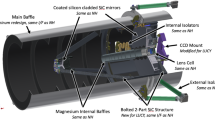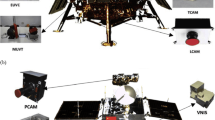Abstract
NASA’s Lunar Precursor Robotic Program (LPRP), formulated in response to the President’s Vision for Space Exploration, will execute a series of robotic missions that will pave the way for eventual permanent human presence on the Moon. The Lunar Reconnaissance Orbiter (LRO) is first in this series of LPRP missions, and plans to launch in October of 2008 for at least one year of operation. LRO will employ six individual instruments to produce accurate maps and high-resolution images of future landing sites, to assess potential lunar resources, and to characterize the radiation environment. LRO will also test the feasibility of one advanced technology demonstration package. The LRO payload includes: Lunar Orbiter Laser Altimeter (LOLA) which will determine the global topography of the lunar surface at high resolution, measure landing site slopes, surface roughness, and search for possible polar surface ice in shadowed regions, Lunar Reconnaissance Orbiter Camera (LROC) which will acquire targeted narrow angle images of the lunar surface capable of resolving meter-scale features to support landing site selection, as well as wide-angle images to characterize polar illumination conditions and to identify potential resources, Lunar Exploration Neutron Detector (LEND) which will map the flux of neutrons from the lunar surface to search for evidence of water ice, and will provide space radiation environment measurements that may be useful for future human exploration, Diviner Lunar Radiometer Experiment (DLRE) which will chart the temperature of the entire lunar surface at approximately 300 meter horizontal resolution to identify cold-traps and potential ice deposits, Lyman-Alpha Mapping Project (LAMP) which will map the entire lunar surface in the far ultraviolet. LAMP will search for surface ice and frost in the polar regions and provide images of permanently shadowed regions illuminated only by starlight. Cosmic Ray Telescope for the Effects of Radiation (CRaTER), which will investigate the effect of galactic cosmic rays on tissue-equivalent plastics as a constraint on models of biological response to background space radiation. The technology demonstration is an advanced radar (mini-RF) that will demonstrate X- and S-band radar imaging and interferometry using light weight synthetic aperture radar. This paper will give an introduction to each of these instruments and an overview of their objectives.
Similar content being viewed by others
References
D.B. Campbell, L.M. Carter et al., in Workshop on Radar Investigations of Planetary and Terrestrial Environments, Houston, TX, vol. 6026 (2005)
E.M. Eliason, A.S. McEwen, M.S. Robinson, E.M. Lee, T. Becker, L. Gaddis, et al., in Abstracts of 30th Lunar Planetary Sciences Conference, abstract 1933 (1999)
W.C. Feldman et al., Science 281, 1496 (1998)
W.C. Feldman et al., J. Geophys. Res. E2 105(1), 4125 (2000)
C.L. Lichtenberg, Bistatic Radar Observations of the Moon Using the Clementine Spacecraft and Deep Space Network, Ph.D. Thesis (1996)
M.C. Malin et al., J. Geophys. Res. 106, 17651 (2001)
D. McCleese, J. Schofield, F. Taylor, S. Calcutt, M. Foote, D. Kass, et al., J. Geophys. Res. (2007, in press)
A.E. Metzger, J.I. Trombka, L.E. Peterson et al., Science 179, 800 (1973)
I.G. Mitrofanov et al., Science 297, 78 (2002)
S. Nozette, C.L. Lichtenberg, P. Spudis, R. Bonner, W. Ort, M. Robinson, E.M. Shoemaker, Science 274, 1495 (1996)
S. Nozette, M.S. Spudis, D.B.J. Robinson, C. Bussey, R. Bonner, J. Geophys. Res. 106(10), 23253 (2001)
S.J. Ostro, in The Encyclopedia of Physical Science and Technology, 3rd edn., ed. by R.A. Meyers (Academic, Orlando, 2002) p. 12295
K.J. Peters, Phys. Rev. Revis. B 46, 801 (1992)
R.K. Raney, in Principles and Applications of Imaging Radar, ed. by F. Henderson, A. Lewis (Wiley, New York, 1998), p. 9
R.K. Raney, Hybrid-Polarity SAR Architecture. CD-ROM Proceedings. IEEE International and Geoscience Remote Sensing Symposium IGARSS, Denver, CO (2006)
D.E. Smith et al., J. Geophys. Res. 106(E10), 23689 (2001)
S.C. Solomon et al., Planet. Space Sci. 49, 1445 (2001)
D.C. Slater, S.A. Stern, T. Booker, J. Scherrer et al., in UV/EUV and Visible Space Instrumentation for Astronomy and Solar Physics, ed. by O.H.W. Siegmund, S. Fineschi, M.A. Gummin, Proceedings of SPIE, vol. 4498 (2001), pp. 239
N.J.S. Stacy, High-Resolution Synthetic Aperture Radar Observations of the Moons (Cornell University, Ithaca, 1993), p. 210
N.J.S. Stacy, D.B. Campbell, in Proceedings IEEE Geoscience and Remote Sensing Symposium IGARSS93, Tokyo, Japan (1993), p. 30
S.A. Stern, J.R. Scherrer, D.C. Slater, G.R. Gladstone, L.A. Young, G.J. Dirks, J.M. Stone, M.W. Davis, in X-Ray, UV, Visible, and IR Instrumentation for Planetary Missions, ed. by O.H.W. Siegmund, G.R. Gladstone. Proceedings of SPIE, vol. 5906B (2005)
S.A. Stern, Rev. Geophys. 37, 453 (1999)
A.P. Vinogradov et al., Space Res. (Russ.) 4, 871 (1966)
R.R. Vondrak, LPI Contrib. 652, 246 (1988)
Author information
Authors and Affiliations
Corresponding author
Rights and permissions
About this article
Cite this article
Chin, G., Brylow, S., Foote, M. et al. Lunar Reconnaissance Orbiter Overview: The Instrument Suite and Mission. Space Sci Rev 129, 391–419 (2007). https://doi.org/10.1007/s11214-007-9153-y
Received:
Accepted:
Published:
Issue Date:
DOI: https://doi.org/10.1007/s11214-007-9153-y




